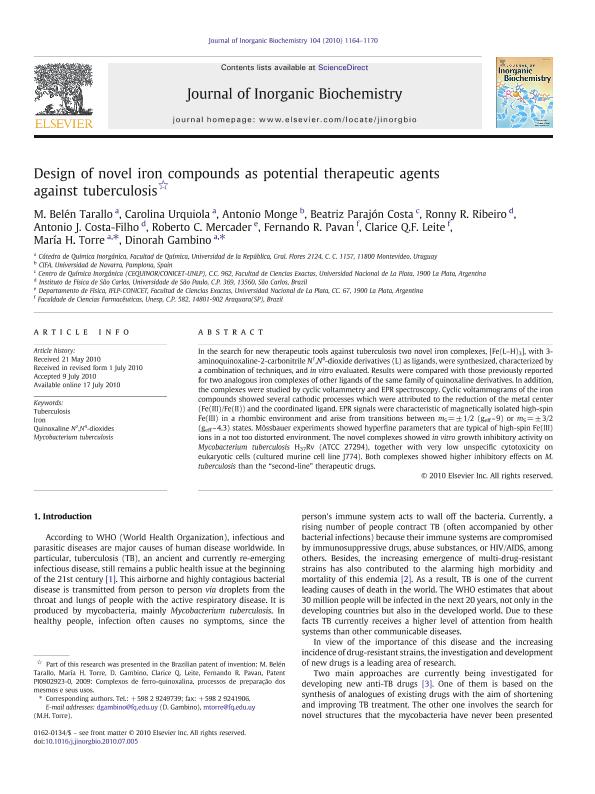Artículo
Design of novel iron compounds as potential therapeutic agents against tuberculosis
Tarallo, M. Belén; Urquiola, Carolina; Monge, Antonio; Parajón Costa, Beatriz Susana ; Ribeiro, Ronny R.; Costa Filho, Antonio J.; Mercader, Roberto Carlos
; Ribeiro, Ronny R.; Costa Filho, Antonio J.; Mercader, Roberto Carlos ; Pavan, Fernando R.; Leite, Clarice Q.F.; Torre, María H.; Gambino, Dinorah
; Pavan, Fernando R.; Leite, Clarice Q.F.; Torre, María H.; Gambino, Dinorah
 ; Ribeiro, Ronny R.; Costa Filho, Antonio J.; Mercader, Roberto Carlos
; Ribeiro, Ronny R.; Costa Filho, Antonio J.; Mercader, Roberto Carlos ; Pavan, Fernando R.; Leite, Clarice Q.F.; Torre, María H.; Gambino, Dinorah
; Pavan, Fernando R.; Leite, Clarice Q.F.; Torre, María H.; Gambino, Dinorah
Fecha de publicación:
11/2010
Editorial:
Elsevier Science Inc
Revista:
Journal of Inorganic Biochemistry
ISSN:
0162-0134
Idioma:
Inglés
Tipo de recurso:
Artículo publicado
Clasificación temática:
Resumen
In the search for new therapeutic tools against Tuberculosis two novel iron complexes, [Fe(L-H)3], with 3-aminoquinoxaline-2-carbonitrile N1,N4-dioxide derivatives (L) as ligands, were synthesized, characterized by a combination of techniques, and in vitro evaluated. Results were compared with those previously reported for two analogous iron complexes of other ligands of the same family of quinoxaline derivatives. In addition, the complexes were studied by cyclic voltammetry and electronic paramagnetic resonance (EPR) spectroscopy. Cyclic voltammograms of the iron compounds showed several cathodic processes which were attributed to the reduction of the metal center (Fe3+/Fe2+) and the coordinated ligand. EPR signals were characteristic of magnetically isolated high-spin Fe(III) in a rhombic environment and arise from transitions between mS= 1/2 (geff~9) or mS= 3/2 (geff~4.3) states. Mössbauer experiments showed hyperfine parameters that are typical of high spin Fe(III) ions in a not too distorted environment. The novel complexes showed in vitro growth inhibitory activity on Mycobacterium tuberculosis H37Rv (ATCC 27294), together with very low unspecific cytotoxicity on eucariotic cells (cultured murine cell line J774). Both complexes showed higher inhibitory effects on M. tuberculosis than the “second-line” therapeutic drugs.
Palabras clave:
Tuberculosis
,
Iron
,
Quinoxaline N1,N4 dioxides
,
Mycobacterium tuberculosis
Archivos asociados
Licencia
Identificadores
Colecciones
Articulos(CEQUINOR)
Articulos de CENTRO DE QUIMICA INORGANICA "DR. PEDRO J. AYMONINO"
Articulos de CENTRO DE QUIMICA INORGANICA "DR. PEDRO J. AYMONINO"
Articulos(IFLP)
Articulos de INST.DE FISICA LA PLATA
Articulos de INST.DE FISICA LA PLATA
Citación
Tarallo, M. Belén; Urquiola, Carolina; Monge, Antonio; Parajón Costa, Beatriz Susana; Ribeiro, Ronny R.; et al.; Design of novel iron compounds as potential therapeutic agents against tuberculosis; Elsevier Science Inc; Journal of Inorganic Biochemistry; 104; 11; 11-2010; 1164-1170
Compartir
Altmétricas



